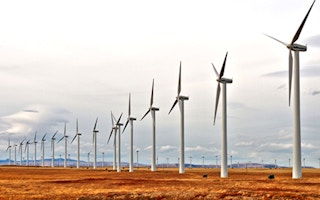Two wind energy projects in Pakistan have successfully registered under the United Nations’ carbon credit scheme, making the wind farms the first of its kind for the South Asian nation.
To continue reading, subscribe to Eco‑Business.
There's something for everyone. We offer a range of subscription plans.
- Access our stories and receive our Insights Weekly newsletter with the free EB Member plan.
- Unlock unlimited access to our content and archive with EB Circle.
- Publish your content with EB Premium.
Umwelt-Projekt-Management (UPM) announced this week it had attained the formal registration of two Pakistani wind farm projects with the United Nations’ Clean Development Mechanism (CDM).
Known as Foundation Wind Energy 1 and Foundation Wind Energy II, these renewable energy projects are subsidiaries of Fauji Foundation, a leading company in Pakistan with a diverse business portfolio.
Fauji enlisted UPM, a climate mitigation project developer and consultancy based in Germany, Pakistan and China, in registering the wind farms as CDM project activities. This way, the wind farms will be able to eventually issue certified emission reduction (CER) credits.
These credits are the foundation of the Clean Development Mechanism of the UN Framework Convention on Climate Change to stimulate sustainable development and reduce greenhouse gas (GHG) emissions.
Developing countries with emission reduction projects can earn CERs that can be traded and sold to developed nations. In turn, these industrialised countries can offset their carbon emissions as required by the Kyoto Protocol or international agreement on lowering emission levels.
According to UPM, Foundation Wind Energy I and II, located on Kutti Kun New Island and near the city of Karachi, will utilise wind resources to generate much needed electricity in the country. Both 50 megawatts in capacity, their combined projected electricity output of 288,200 MWh per year will replace the fossil fuel-sourced electricity from the current Water and Power Development Authority (WAPDA) grid.
“The project activities will not only contribute significantly to closing Pakistan’s massive energy supply gap but will also achieve total combined greenhouse gas emission reductions of approximately 1.78 million tonnes of carbon dioxide equivalents (tCO2e) throughout their entire crediting period of 10 years,” explained UPM.
The two wind farm projects will also offer numerous job opportunities during the construction phase and the operational period.
Foundation Wind Energy I is expected to commence commercial operation on the last quarter of this year, said Fauji. Once on-going, together with the second wind-based power plant, these will help spur economic growth in the country.
Asian Development Bank, one of the foreign lenders for the wind farms, stated, “The successful implementation of the projects is expected to foster confidence amongst potential investors and lenders and promote further private sector investment in the country’s renewable energy and power sector.”
Meanwhile, Martin Dilger, managing director of UPM’s main office in Germany, said, “The two 50 MW Foundation wind energy projects are among the first of its kind in Pakistan. They build upon UPM’s valuable experience gained with the Pakistani Sapphire and Yunus wind power projects that UPM already registered with the CDM earlier.”








